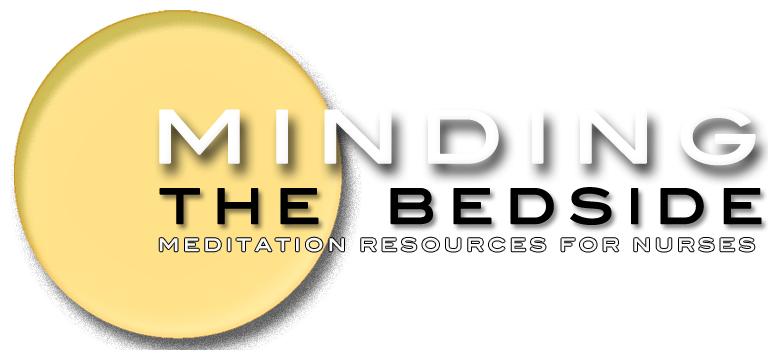Please enjoy this guest post from Jerome Stone, RN, of Minding the Bedside:

STRESS(ORS) IN NURSING
When it comes to stress, nurses know what it feels like to not only have too many things to do and too many tasks to accomplish but also to have peoples’ lives and well-being depend upon us.
Considering that stress is a “given” in our profession, how do we deal with it so that it doesn’t impact us in our health, in our home lives, and our physical, mental, and spiritual well-being?
Before we go any further, it’s crucial for us to define a few terms (and I’ve already used the word “stress” incorrectly on purpose), because there’s often a misunderstanding between stressors and stress, and between emotions and feelings.
IMPORTANT DEFINITIONS
Definition of stressor – A stressor is a chemical or biological agent, environmental condition, external stimulus, or an event that causes you to experience stress.
Stressors are the things in life and your environment that (may) cause you to experience stress; they’re the things at work or in life that can elicit a stress response from you.
People often define stressors as the experience of “stress.” For example, “I’ve got relatives coming for the holidays.” (stressor); “My kids are driving me crazy.” (stressor); “My work is so stressful.”(stressor); “I’m going back to school.” (stressor).
Definition of stress – A state of bodily or mental tension resulting from factors (stressors) that tend to affect or change an existent equilibrium.
Stress is a state or the physiology that we experience when a stressor triggers an emotional response, and we experience it when we allow the stressors in life to take over. I used the word “allow” because we have more choice (than we think) in whether or not to react to stressors and experience stress. Because stress is a state, it’s also changeable and malleable – we can work with it.
Now, there are two additional definitions and concepts that we need to review here:
Definition of emotions – Emotions are the physiology of complex reactions the body has to certain stimuli; they’re how our body interprets data from the outer world, and in some cases, how we experience stress. Emotions are generally automatic and unconscious; they occur in response to a stressor, many times without our conscious awareness that they’re arising. And then we say, “I’m stressed out!”
Emotions can come about automatically and unconsciously. Learning to be mindful is about becoming more aware. Even if an emotional response is automatic, we can become conscious of it and learn how to work with it.
Definition of feelings – Feelings are how our mind interprets our emotions. We experience a rapid heart rate, or fast breathing, and “feel” (interpret these emotions) as excitement, anxiety, or anger, often towards or about the stressor/stimulus, e.g. my teenager is stressing me out!
The use of the word mind here is essential (and purposeful) because that’s what we’ll work with to become less stressed.
BRINGING IT ALL TOGETHER
So, to bring it all nicely together:
Stressors trigger the emotional component of our experience, and our interpretation of our emotions are our feelings, which may result in us experiencing stress.
It’s important to know the difference between stressor and stress and emotions and feelings because it’s by learning what we can change, i.e. our stress-response and our interpretation of emotions, that we can manage stress and its effects on us.
This is a significant point. Until we understand that trying to change our environment “out there” has its limitations, and that managing stress comes from an internal locus of change, we’ll be caught up in the emotional/stressed whirlpool of our own making.
I think that it’s also important to understand that not everyone experiences stressors as stress or as negative emotions. Here’s an example; you may be afraid of heights, and just the thought of being up high on a ledge brings queasiness to your stomach. But another person, perhaps a rock climber, thrives on the feelings that she experiences when she’s up on the rocks; she experiences it as eustress (good stress). So in this example, height is your stressor but is not universally so.
Why am I making this distinction? Because, by knowing this, it enables us, in theory, to change the way that we respond to stressors because we understand that it’s not something “out there” that’s causing us to experience stress, it’s inside our mind!
WHO ARE YOU…WHEN YOU’RE NOT STRESSED?
Have you ever had a time in your life when you weren’t stressed? Of course, you have!
So, what’s the difference between the unstressed “you” and the “you” who get stressed?
We all have the potential not to be stressed. The only difference between who we are when we are stressed and who we are when we’re not is in one case, we’re reacting to a stressor, and in the other, we’re not. Hmmm…
So, how do you stay with the less-stressed you and not get caught up in the “stressed you?”
Here’s something to keep in mind…literally:
That which is stress-free already resides within you; your process isn’t about “becoming” less stressed. It’s about recognizing the aspect of yourself that already is stress-free and reconnecting with that state of mind repeatedly until it becomes a habit.
What do I mean here?
You’re already wired to be stress-free, right? If you can be stress-free some of the time, chances are you can be stress-free more of the time.
So, how do we usually try to deal with our stress?
We try to control our environment. We try to control all of the stressors in our lives. Does that work? Not really. There is an endless number of stressors available to test our stress-reactivity. We could spend our entire lives trying to control our environment. It simply doesn’t work.
If we go back to our definitions, and try to figure out which of the four components – stress, stressors, emotions, feelings – we can work with most efficiently, we quickly understand that since we can’t control stressors because they’re always “out there.” And we can’t always get a grip on our emotions because they’re always “in here.” That leaves us with either controlling stress (how we react to stressors) or reinterpreting our feelings. We can do both at once! Here’s how!
MINDFULNESS
You may have heard the word mindfulness used as a form of concentration or meditation. Mindfulness, like meditation, is the process of bringing your focus to an object, perhaps to your breath, as a means of anchoring in the moment-to-moment awareness. It’s also the beginning of how we rescue ourselves from our habitual patterns of acting or reacting to circumstances in the same old way that we’ve always done.
When you practice mindfulness, you begin by using the breath to anchor your attention. The breath is always with you and can be accessed anytime as a means to bring yourself into the present moment. By anchoring your attention somewhere other than on your thoughts or emotions, you can begin to rein in your wandering mind, bringing it back home to your true nature. And – WATCH! – here’s the magic. Once you’ve learned how to bring your attention back to the present mindfully, you’ll begin to recognize when you’re experiencing stress. THAT recognition is how you’ll start to de-stress more easily; acknowledging that you’re stressed, and work with whatever is triggering your stress reactivity.
Is this easy? No. It takes time.
Is it worth it? Yes!
THE MAGIC OF MINDFULNESS
When we’re in a stress-reactive state due to a perceived threat — whether it’s happening in real-time or something we tell ourselves about ourselves e.g. “I can’t take tests!” — we experience physiological stress due to a stimulus or stressor.
When we’re mindful, and this will happen each time that we bring mindfulness into play, we first realize that we’re experiencing stress. Then by attending to our stress reaction, we can investigate whether what we’re experiencing is valid, i.e. are we about to face certain death or whether we’re reacting out of habit.
Mindfulness slows down the habitual reactivity of the body and mind.
There are TONS of methods for learning mindfulness, some more effective than others. Here’s a great mindfulness script that you can download here that I’ve shared with hundreds (if not thousands!) of nurses (Audio mp3 version: download it here).
BREAKING HABITS TAKES TIME
To learn to tame your habitual reactivity will take time…but it’s worth it! You’ll fail, then have a little success, then fail again, then succeed, and then fail again. That’s good. It means you’re progressing.
Each moment of mindfulness is one less moment of reactivity.
Jerome Stone is a Registered Nurse with over thirty years of experience in a variety of health-care settings, including pain management, hospice care, oncology, ICU, and research in neurology, and complementary and alternative medicine. He is a long-time practitioner of meditation, with an emphasis on the study of cross-cultural contemplative practices. He lives in Boulder, Colorado, with his wife Jill and their son, Noah.
Jerome is the author of the book, Minding the Bedside: Nursing from the Heart of the Awakened Mind, a book for nurses on how to reduce stress in the workplace through meditation and compassion practices. He also blogs on his site, Minding the Bedside, and teaches courses based on the methods presented in his book. Additionally, he has been trained in and teaches Mindfulness-Based Stress Reduction (MBSR). He is a speaker on the topics of stress management, meditation, mindfulness, and compassion.
“Please feel free to drop me a line and let me know how you’re doing.” -Jerome Stone

